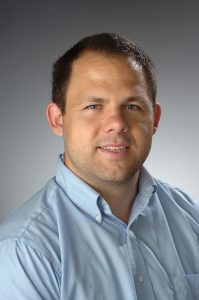 A Syracuse University Story by Jay Cox originally published on April 7, 2020.
A Syracuse University Story by Jay Cox originally published on April 7, 2020.
When David Larsen first learned of the novel coronavirus outbreak in Wuhan, China, he hoped it would be contained. Larsen, an environmental epidemiologist and associate professor of public health at Falk College, says that region of the world had previously experienced SARS-1 and MERS epidemics, so the health care system was ready to help battle the COVID-19 spread.
COVID-19 is less deadly than either of those viruses, but more contagious, Larsen says. The coronavirus has now ravaged populations worldwide, and North America’s first confirmed case appeared in Washington in late January. “When scientists in Washington showed that two cases of COVID-19 were genetically identical—and they were a month apart—that’s when I realized it would be bad,” Larsen says. “The acceleration of this growth surprised me, but it won’t surprise me anymore.”
As we grapple with the pandemic, Larsen urges people to follow recommended public health guidelines to help break chains of transmission and flatten the curve of communal spread. He responds to our questions about the new disease, offering insights on the virus and how, both as individuals and a society, we can work together in our attempt to control it.
How threatening is the virus because of its ability to spread so rapidly?
The first death in the U.S. was February 27. By March 27, there were 1,000 deaths, and by March 29, we had 2,000 deaths. This acceleration is hard to understand until you’re actually seeing it that big, that fast. It’s twice as infectious as influenza. Because the pathogen is so contagious, it’s dangerous in its spread, and our world is so connected.
When the U.S. government placed the travel ban for China, it was too late—the virus had already escaped and been seeded throughout Europe and the U.S. That happened early and surprised a lot of people.
Why is it important to wear a face mask?
The entire country should be wearing face masks in public to help reduce transmission of the coronavirus. If we get enough people wearing masks, asymptomatic and pre-symptomatic people will reduce the infected droplets coming from them when they talk and breathe. There’s also evidence a mask provides some personal protection, so it’s both a personal protection and a community protection intervention.
We need to bring anything that can work to the fight, and face masks may help. There are no randomized studies to rely on to guide our interventions. But evidence from historical studies, filtration experiments and observational studies suggests that when the entire community wears face masks in public, the transmission of respiratory infections will decrease.
The caveat is that we also have a huge shortage of face masks for the health care workers. Nobody should be wearing a medical-grade mask in public unless they’re super high risk. It should be a homemade cloth mask, even a scarf or a bandana would work better than nothing. We need to challenge the public to both sew one billion cloth face masks (free templates are available online) and wear them in public at all times. This can help further flatten the curve beyond what social distancing can achieve alone.
You’ve cited Taiwan for its comparatively low communal spread. What lessons should we learn from Taiwan’s approach?
This is the third coronavirus that Taiwan’s had to deal with in less than 20 years. They are prepared and ready to go. When we compare the U.S. response, we’re basically rookies and need to adopt their playbook. One interesting thing Taiwan does is track their citizenry quite heavily through mobile phones. If they identify one person who has the coronavirus, they can immediately alert everybody who’s been within six feet and say, “You need to go into quarantine for the next 14 days; we’ll follow up with you later.” They have been able to track people that way, including incoming travelers.
What advice do you have for families in their home environment?
If we think about social distancing, we should think about our social network. We want to have a closed social network that does not ever come into contact with the virus. But every single contact outside of that household—whether it’s through a drive-thru, a restaurant, grocery store, post office or work—comes with a probability of transmission. Once the virus gets into that closed network, it would spread through the family unit.
Along with following guidelines and being vigilant, what should we do moving forward?
The big thing we need to do is increase our surveillance—increase our capacity as a country, state and county to know where the virus is. First, we need to change the case definition. Right now, a COVID-19 case has to be diagnosed by the laboratory diagnostic. Let’s change the case definition to any viral pneumonia with unknown cause, since the majority of these cases will be COVID-19 and that will give us a truer picture of the numbers we’re facing in this country.
Second, we should include novel types of viral surveillance. In many disease systems, we use environmental surveillance to look for the virus in wastewater, in human sewage. There may be capacity for that with the coronavirus, but that needs to be a fast-track study and, if the proof of concept is there, let’s scale that across the country. Then, at a municipal level, we could establish which cities have coronavirus transmission and which don’t, instead of relying just on the cases showing up at the health center.
It’s a big learning curve for us—this is our country’s first experience with a novel deadly respiratory illness. Hopefully, what we’ve learned will help us to prepare for the next time this happens, because it will happen again, and we need to be ready for it.
